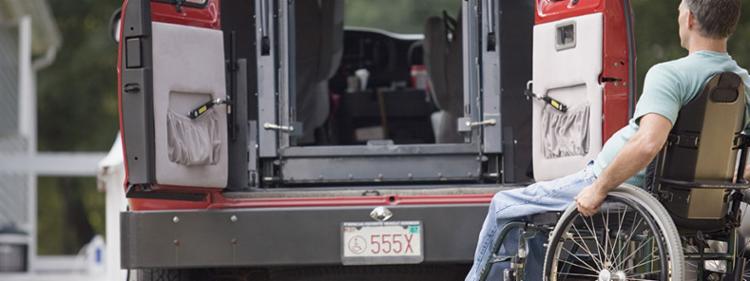The Complete Guide to Wheelchair Vans

Whether you've just begun looking for a wheelchair van or you've been in the market for one for quite some time, it's important to know the ins and outs of these vehicles, along with the resources available to you as a buyer.
This list of resources to help you find the best wheelchair van for your situation, along with budget tips, aid resources and much more. Find out more by contacting an insurance agent in your area who can help you find affordable car insurance.
Here are just a few statistics surrounding the wheelchair van industry:
- 54 million people in the United States are disabled.
- 5% of children 5 to 17 years of age have disabilities.
- 10% of adults aged 18 to 64 years of age have disabilities.
- 38% of those 65 years and older have disabilities.
Since these numbers add up to reflect a large portion of the nation, many businesses do their best to accommodate. This includes installing ramps, having mobility scooters available and even providing free help to/from your car. However, this help ends at the vehicle. This is where wheelchair vans and wheelchair ramps for vans and minivans come in.
Wheelchair vans originate in regular factories, on the assembly line next to regular vans. Once fully assembled, they make their way to a wheelchair van conversion facility. Many shops around the nation convert regular vans into wheelchair vans or install wheelchair ramps on vans. Once the conversions are complete, the shops ship them back to the dealer or directly to the customer.
Step 1: Get an Idea of What You Want
According to the National Mobility Equipment Dealers Association, it's important to have a good grasp of what equipment your wheel chair van needs. Not every disability is the same, and there are different equipment options available for different disabilities.
When you contact the NMEDA, they'll get to know you and will be able to suggest a wheel chair van that will fit your particular needs. Create a list of features you want, need and have to have in order to get a few different cost options. Also, make sure that you're allowing enough room to transport friends or family.
Step 2: Get an Evaluation and a Prescription
The NMEDA will then assign you a Certified Driver Rehabilitation Specialist. This individual will come to your home (there are more than 600 dealers nationwide with these specialists on staff) and will go on a drive with you, evaluating your skills, needs, vision, coordination and strength.
The CDRS will then give you a written prescription for a wheelchair van that will suit your needs or a prescription for a wheelchair ramp for an existing van or minivan.
Step 3: Decide on a Budget/Get Aid Resources
With your prescription, you can begin the search for a wheelchair van or a ramp. There are many wheelchair van dealers throughout the nation, and each one has the ability to get you the van you need. According to CarsDirect, the typical makes and models of wheelchair vans are the Ford E-150, Chrysler Town and Country, Dodge Grand Caravan, or a Honda Odyssey.
You can either purchase the van from a regular dealer and then have it converted into a wheelchair van, have it outfitted with a wheelchair ramp, or purchase the wheelchair van from a wheelchair van dealer. AbilityCenter recommends purchasing a pre-fabricated wheelchair van, as the costs to convert a regular van into a wheelchair van can get quite exorbitant.
However you choose to purchase your van, make sure to talk with the Better Business Bureau or the Consumer Affairs division closest to you to make sure that you're dealing with a reputable company.
There are many special aid resources available for those looking to get a wheelchair van. Special Kids Fund works with local charities to help both kids and adults get wheelchair vans. Nice Guys San Diego is another charity that helps individuals get wheelchair ramps for vans or wheelchair vans.
If you are a disabled vet, the government has special programs to help you get a wheelchair van. Many states have grant programs available or low interest financing for individuals attempting to purchase a wheelchair van. AMSVans has compiled a state-specific list of grants. You may also be able to get funds donated through a church or local charity group.
Step 4: Maintain Your Wheelchair Van
Wheelchair ramps installed on wheelchair vans need proper maintenance. CarsDirect estimates that maintenance on a wheelchair van or ramp is almost $3,500 per year. There are programs for veterans to help with maintenance costs. Many charities and organizations that provide funding to the disabled require maintenance on the vehicle in order to continue the financing.
Because wheelchair vans and other adaptive vehicles have expensive after-market add-ons, there's also the issue of vehicle insurance to think about. You may qualify for certain discounts based on the affiliations you have, and you may be buying these on behalf of a commercial enterprise and be able to write off part of the insurance.
Either way, being able to secure a low rate for your van is probably at the top of your priority list. Independent agents make comparison shopping for auto insurance easy. Independent agents are affiliated with more than one insurer, unlike captive agents, and can produce several quotes for you to compare before you buy.
http://www.benefits.va.gov/BENEFITS/factsheets.asp#BM2
http://www.amsvans.com/financing-handicap-vans/grants/state-disability-grants
